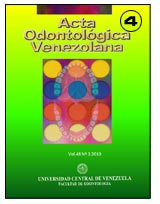ACTIVIDAD ANTIBACTERIANA Y CLÍNICA DE LA MOXIFLOXACINA COMPARADA CON OTROS ANTIBIÓTICOS PARA EL MANEJO DE INFECCIONES BUCALES
Keywords:
Infecciones odontogénicas, tratamiento, antibiótico, moxifloxacina, Odontogenic infections, treatment, antibiotic, moxifloxacinAbstract
La cavidad bucal constituye uno de los principales nichos ecológicos para bacterias aerobias yprincipalmente anaerobias. Estos microorganismos juegan un papel importante en la patogénesis de las infecciones bucales y en las infecciones focales de origen oral. Las infecciones bucales más frecuentes incluyen caries, periodontitis, absceso periapical, absceso periodontal, pericoronitis, pulpitis, osteítis e infección de los espacios aponeuróticos. Algunos estudios indican un aumento en la prevalencia de microorganismos presentes en la cavidad bucal que son resistentes a algunos de los antibióticos usualmente empleados para combatir este tipo de infecciones, por lo cual es necesario tener presente antibióticos alternativos parauso terapéutico o profiláctico. Moxifloxacina (MXF) es una 8-methoxiquinolona de amplioespectro, eficaz contra patógenos respiratorios intracelulares típicos y atípicos, bacterias gram negativas y muchas bacterias anaeróbicas obligadas. MXF es también muy activo contra cepas que son resistentes a la penicilina, macrólidos, tetraciclinas, thrimethoprim/sulfa y algunasfluroquinolonas. Cuando se compara con la amoxicilina/clavulánico (AMX-CLA), el esquema dedosificación de la MXF (400 mg/diarios), podría garantizar un mayor cumplimiento con lasprescripciones. Además, su mecanismo de acción también puede proporcionar un alivio más rápido de los síntomas de la infección odontogénica, convirtiéndose en una posible alternativa antimicrobiana contra anaerobios obligados residentes en la cavidad bucal.
AbstractThe oral cavity constitutes one of the principal ecological niches for obligate anaerobic bacteria. These microorganisms play an important role in the pathogenesis of oral infections and focalinfections of oral origin. Most of these infections are odontogenics, being the most frequentdecays, periodontitis, periapical abscess, periodontal abscess, pericoronitis, pulpitis, osteitisand infection of the aponeurotic spaces. Some published studies highlight the growingprevalence of obligate anaerobes in oral origin that are resistant to some of these antibiotics,giving rise to the need to investigate alternative antibiotics for therapeutic or prophylactic use.Moxifloxacin (MXF) is an 8-methoxyquinolone with a broad spectrum of activity, includingactivity against typical, atypical and intracellular respiratory pathogens, gram negative pathogens and many obligate anaerobic bacteria. MXF is also highly active against strains thatare resistant to penicillin, macrolides, tetracyclines, trimethoprim/sulfamethoxazole and somefluoroquinolones. The dosing schedule of the MXF (400 mg / day) could ensure greater compliance with the requirements and its mechanism of action may also provide a faster reliefof symptoms of infection odontogenic, when compared with amoxicillin / clavulanate (AMXCLA).In addition, may represent a possible alternative antimicrobial against oral anaerobes.

